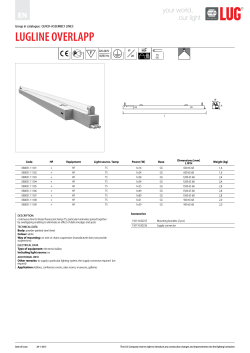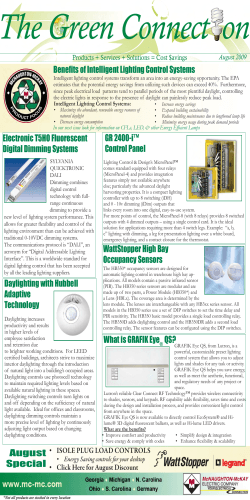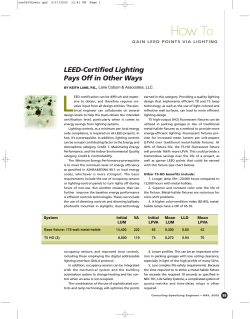
How to save £13k on
project UNIVERSITY OF WARWICK How to save £13k on car park light Vandal-resistant Denver Elite Wall LEDs from Holophane are fitted in the stairwells, and the Aeris LED was used on the top floor. The fittings are IP65rated against dust and moisture ingress. The DSI and Dali-compatible sensors detect activity and monitor daylight. All-LED building The University of Warwick has slashed its annual electricity bill in one of its car parks by more than three quarters. Pennie Varvarides finds out how Price says: ‘We have ended up with a lighting system in this car park that provides more widespread illumination, delivers white light, and provides a safer environment – yet manages to save us more that £13,000 off our annual energy bill.’ This all made for the university’s first all-LED car park. The upgraded lighting cuts electricity consumption at the car park from 19.7 to 4.62kWh, significantly reducing its energy bill and carbon footprint. This represents a financial saving of over £13,000 a year, based on typical electricity costs of 10p/kWh. On top of the cash savings, the university has also slashed its CO2 emissions by 72 tonnes a year, which Price says is a ‘significant achievement’. Controls from Ex-Or have been used in a further three campus car parks, boosting total annual savings to £50,000. The new lighting responds to daylight and occupancy ENERGY DASHBOARD A ging yellow sodium lamps have been replaced with modern alternatives at the University of Warwick’s central campus multi-storey car park. The four-storey car park has 400 spaces and is used by the university staff and students, as well as members of the public who attend events at the adjacent Warwick Arts Centre. The space was originally lit by Holophane’s Parkpack sodium units, and it was bathed in a 24/7 orange glow, regardless of whether anyone was inside. Gary Price, electrical services design engineer at the university’s estates office, says: ‘We knew there had to be potential for a massive saving in energy use if we could cut out the unnecessary use of lighting.’ 66 | www.luxmagazine.co.uk | February 2013 The Denver Elite Wall fitting is available in HID, CFL and LED versions Old bodies, new sources The university turned to LEDs and controls to help it hit its energy conservation targets. The luminaire bodies were in good condition, so electrical contractor Drakeset replaced the SON gear trays with new retrofit 56W LED units with programmable drivers. The units were redesigned to accommodate Philips Fortimo LLM modules. Lighting control was achieved using Ex-Or BattenFit batten-mounted detectors in each luminaire. These hold the light output of the luminaires to 10 per cent and brighten to full output only when activity is detected. When the area is vacated they dim back down to 10 per cent after a two-minute delay. A further 81 new LED luminaires where installed in areas previously left in darkness. @Lux_magazine 77% £13,210 Energy reduction Annual energy savings New LED luminaires have brightened up the stairwells Hopwood Hall College Hopwood Hall College runs a range of degree and diploma courses at its Rochdale and Middleton campuses. When designing the new college car park it was decided that LEDs would be the best option, based on their energy-saving potential. But the lighting didn’t just have to keep electricity costs down, it had to provide good quality of light for staff and students. The road to the new car park has been lined with LED Denver Elite Bollard fittings from Holophane and the main parking area uses Holophane’s Factor LED column-mounted lanterns, delivering 11,000 lm in a combination of asymmetric and ‘long and and narrow’ distributions. At the campus end of the car park, perimeter lighting is provided by Denver Elite Wall LED fittings, from the same luminaire family as the entrance lights. @Lux_magazine www.luxmagazine.co.uk | February 2013 | 67 project UNIVERSITY OF WARWICK How to save £13k on car park light Vandal-resistant Denver Elite Wall LEDs from Holophane are fitted in the stairwells, and the Aeris LED was used on the top floor. The fittings are IP65rated against dust and moisture ingress. The DSI and Dali-compatible sensors detect activity and monitor daylight. All-LED building The University of Warwick has slashed its annual electricity bill in one of its car parks by more than three quarters. Pennie Varvarides finds out how Price says: ‘We have ended up with a lighting system in this car park that provides more widespread illumination, delivers white light, and provides a safer environment – yet manages to save us more that £13,000 off our annual energy bill.’ This all made for the university’s first all-LED car park. The upgraded lighting cuts electricity consumption at the car park from 19.7 to 4.62kWh, significantly reducing its energy bill and carbon footprint. This represents a financial saving of over £13,000 a year, based on typical electricity costs of 10p/kWh. On top of the cash savings, the university has also slashed its CO2 emissions by 72 tonnes a year, which Price says is a ‘significant achievement’. Controls from Ex-Or have been used in a further three campus car parks, boosting total annual savings to £50,000. The new lighting responds to daylight and occupancy ENERGY DASHBOARD A ging yellow sodium lamps have been replaced with modern alternatives at the University of Warwick’s central campus multi-storey car park. The four-storey car park has 400 spaces and is used by the university staff and students, as well as members of the public who attend events at the adjacent Warwick Arts Centre. The space was originally lit by Holophane’s Parkpack sodium units, and it was bathed in a 24/7 orange glow, regardless of whether anyone was inside. Gary Price, electrical services design engineer at the university’s estates office, says: ‘We knew there had to be potential for a massive saving in energy use if we could cut out the unnecessary use of lighting.’ 66 | www.luxmagazine.co.uk | February 2013 The Denver Elite Wall fitting is available in HID, CFL and LED versions Old bodies, new sources The university turned to LEDs and controls to help it hit its energy conservation targets. The luminaire bodies were in good condition, so electrical contractor Drakeset replaced the SON gear trays with new retrofit 56W LED units with programmable drivers. The units were redesigned to accommodate Philips Fortimo LLM modules. Lighting control was achieved using Ex-Or BattenFit batten-mounted detectors in each luminaire. These hold the light output of the luminaires to 10 per cent and brighten to full output only when activity is detected. When the area is vacated they dim back down to 10 per cent after a two-minute delay. A further 81 new LED luminaires where installed in areas previously left in darkness. @Lux_magazine 77% £13,210 Energy reduction Annual energy savings New LED luminaires have brightened up the stairwells Hopwood Hall College Hopwood Hall College runs a range of degree and diploma courses at its Rochdale and Middleton campuses. When designing the new college car park it was decided that LEDs would be the best option, based on their energy-saving potential. But the lighting didn’t just have to keep electricity costs down, it had to provide good quality of light for staff and students. The road to the new car park has been lined with LED Denver Elite Bollard fittings from Holophane and the main parking area uses Holophane’s Factor LED column-mounted lanterns, delivering 11,000 lm in a combination of asymmetric and ‘long and and narrow’ distributions. At the campus end of the car park, perimeter lighting is provided by Denver Elite Wall LED fittings, from the same luminaire family as the entrance lights. @Lux_magazine www.luxmagazine.co.uk | February 2013 | 67
© Copyright 2026





















